Interpreting glucose curves
See the Blood Glucose Curves section for additional recommendations.
While blood glucose curves (BGC) are an important monitoring tool, they have limitations. Where diabetes mellitus (DM) monitoring is concerned, clinical signs supersede all else. When the patient has no clinical signs and the body weight is steady or increasing, DM is likely controlled.
In assessing a BGC, whether it is the first curve performed on a patient or the most recent of many, three basic questions must be asked:
- What is the nadir?
- Has the insulin succeeded in lowering blood glucose (BG) to an ideal nadir of 80–150 mg/dL?
- What was the duration of action of the insulin?
- How long has the BG been controlled between 80–200 mg/dL in dogs or 80–300 mg/dL in cats?
- Are clinical signs of hyper- or hypoglycemia reported?
By answering these questions, appropriate treatment suggestions can be made.
Below are samples of glucose curves demonstrating various scenarios and recommendations.
Optimal canine glucose curve
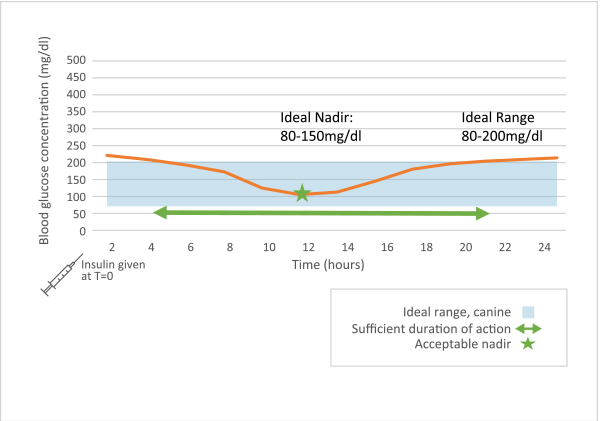
- What is the nadir? 110 mg/dL. It is ideal.
- What was the duration of action of the insulin? BG is within 80–200 mg/dL for a majority of the day.
- Are clinical signs of hyperglycemia reported?
NO:
- Treatment suggestion:
- Do not change insulin regimen. Assume the dog is controlled.
YES:
- Treatment suggestion:
- Do not change insulin dose yet.
- Consider the possibilities that the BGC is not reflective of overall control, there is an overlap of insulin action, or another disease is causing clinical signs.
See the Monitoring section for additional information.
Optimal feline glucose curve
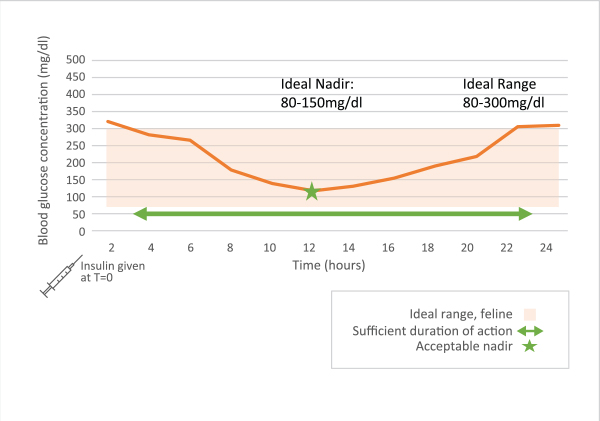
- What is the nadir? 120 mg/dL. It is ideal.
- What was the duration of action of the insulin? BG is within 80–300 mg/dL for a majority of the day.
- Are clinical signs of hyperglycemia reported?
NO:
- Treatment suggestion:
- Do not change the insulin regimen. Assume the cat is controlled.
YES:
- Treatment suggestion:
- Do not change insulin dose yet. Consider the possibilities that the BGC is not reflective of overall control, there is an overlap of insulin action, or another disease is causing clinical signs.
See the Monitoring section for additional information.
Persistent hyperglycemia
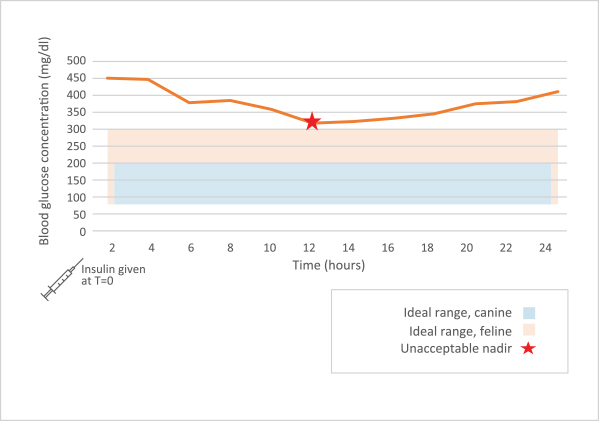
- What is the nadir? 320 mg/dL. The nadir is too high.
- What was the duration of action of the insulin? BG was never below 300 mg/dL at any time during the day.
- Are clinical signs of hyperglycemia reported?
NO:
- Treatment suggestion:
- Consider stress hyperglycemia.
- If weight is stable, leave dose unchanged and recheck in 1–3 months
- If weight is decreasing, increase dose and recheck in 14 days
- Consider stress hyperglycemia.
YES:
- Treatment suggestion:
- Increase insulin dose and recheck BGC in 7–14 days.
- In dogs, increase insulin by 10–25%
- In cats, increase insulin by 0.5–1 U/dose
- Increase insulin dose and recheck BGC in 7–14 days.
See the Monitoring and Troubleshooting sections for additional information.
Short duration of action of insulin
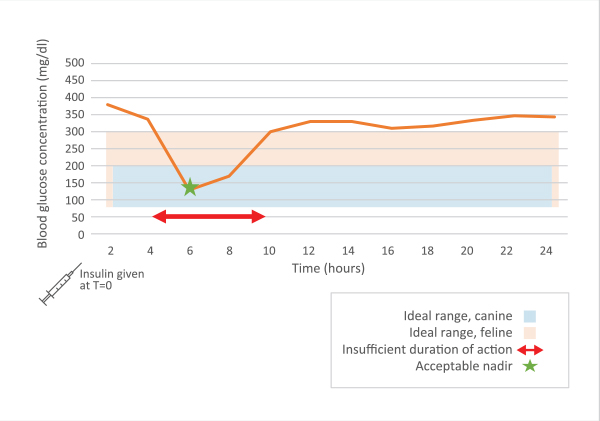
- What is the nadir? 140 mg/dL. It is ideal.
- What was the duration of action of the insulin? BG is within the ideal range for only six hours.
- Are clinical signs of hyperglycemia reported?
NO:
- Treatment suggestion:
- Consider the presence of stress hyperglycemia and do not adjust the insulin dose.
- Try to obtain a BGC at home or in a less stressful setting.
YES:
- Treatment suggestion:
- If giving insulin once a day, increase to twice daily therapy.
- If giving insulin twice a day, consider changing insulin.
See the Monitoring and Troubleshooting sections for additional information.
Hypoglycemia-induced hyperglycemia
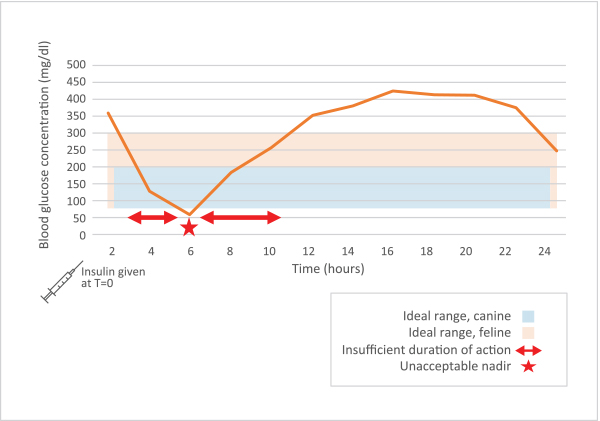
- What is the nadir? 65 mg/dL. The nadir is too low.
- What was the duration of action of the insulin? BG is within the ideal range for only 10 hours.
- Are clinical signs of hyperglycemia reported?
NO:
- Treatment suggestion:
- Decrease insulin dose by 10-25% in dogs or 0.5–1 U in cats.
YES:
- Treatment suggestion:
- Treat as necessary to stabilize pet.
- Decrease insulin dose by 50% or 0.5–1 U in cats.
In either case, obtain a BGC after the next dose to ensure hypoglycemia does not recur.
See the Monitoring section for additional information.



